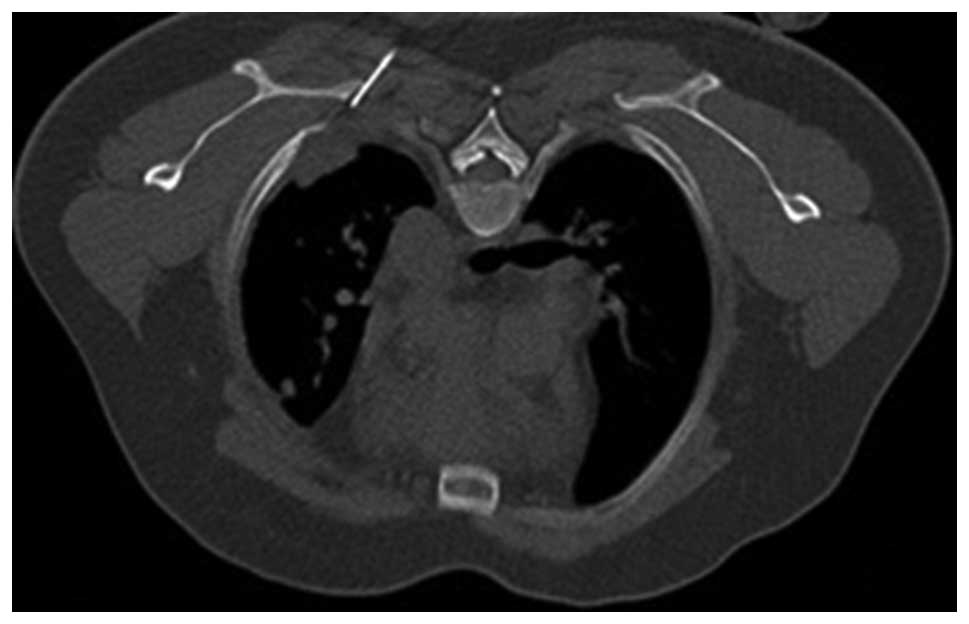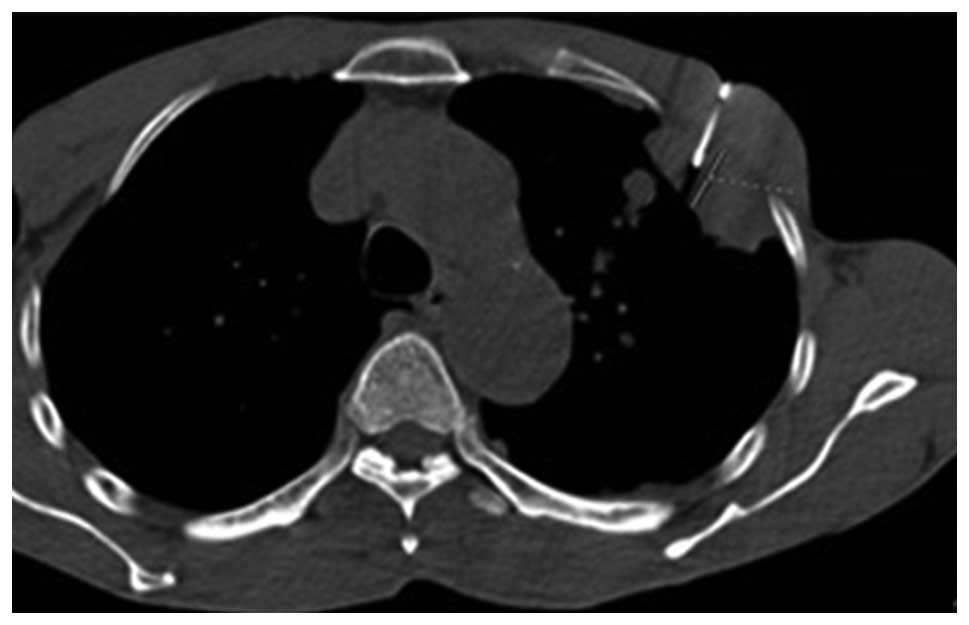|
1
|
Du Rand I and Maskell N: Introduction and
methods: British Thoracic Society Pleural Disease Guideline 2010.
Thorax. 65(Suppl 2): ii1–ii3. 2010. View Article : Google Scholar : PubMed/NCBI
|
|
2
|
Koegelenberg CF and Diacon AH: Pleural
controversy: closed needle pleural biopsy or thoracoscopy-which
first? Respirology. 16:738–746. 2011. View Article : Google Scholar : PubMed/NCBI
|
|
3
|
Renshaw AA, Dean BR, Antman KH, Sugarbaker
DJ and Cibas ES: The role of cytologic evaluation of pleural fluid
in the diagnosis of malignant mesothelioma. Chest. 111:106–109.
1997. View Article : Google Scholar : PubMed/NCBI
|
|
4
|
Hooper C, Lee YC and Maskell N: BTS
Pleural Guideline Group: Investigation of a unilateral pleural
effusion in adults: British Thoracic Society pleural disease
guideline 2010. Thorax. 65(Suppl 2): ii4–ii17. 2010. View Article : Google Scholar
|
|
5
|
Fassina A, Fedeli U, Corradin M, Da Frè M
and Fabbris L: Accuracy and reproducibility of pleural effusion
cytology. Leg Med (Tokyo). 10:20–25. 2008. View Article : Google Scholar
|
|
6
|
Tomlinson JR: Invasive procedures in the
diagnosis of pleural disease. Semin Respir Med. 9:30–60. 1987.
View Article : Google Scholar
|
|
7
|
Lee P, Hsu A, Lo C and Colt HG:
Prospective evaluation of flex-rigid pleuroscopy for indeterminate
pleural effusion: Accuracy, safety and outcome. Respirology.
12:881–886. 2007. View Article : Google Scholar : PubMed/NCBI
|
|
8
|
Sconfienza LM, Mauri G, Grossi F, et al:
Pleural and peripheral lung lesions: comparison of US- and
CT-guided biopsy. Radiology. 266:930–935. 2013. View Article : Google Scholar
|
|
9
|
Chira R, Chira A and Mircea PA:
Intrathoracic tumors in contact with the chest wall -
ultrasonographic and computed tomography comparative evaluation.
Med Ultrason. 14:115–119. 2012.PubMed/NCBI
|
|
10
|
Ferretti GR, Busser B, de Fraipont F,
Reymond E, et al: Adequacy of CT-guided biopsies with
histomolecular subtyping of pulmonary adenocarcinomas: influence of
ATS/ERS/IASLC guidelines. Lung Cancer. 82:69–75. 2013. View Article : Google Scholar : PubMed/NCBI
|
|
11
|
Gupta S and Madoff DC: Image-guided
percutaneous needle biopsy in cancer diagnosis and staging. Tech
Vasc Interv Radiol. 10:88–101. 2007. View Article : Google Scholar : PubMed/NCBI
|
|
12
|
Maskell NA, Gleeson FV and Davies RJ:
Standard pleural biopsy versus CT-guided cutting-needle biopsy for
diagnosis of malignant disease in pleural effusions: a randomised
controlled trial. Lancet. 361:1326–1330. 2003. View Article : Google Scholar : PubMed/NCBI
|
|
13
|
Benamore RE, Scott K, Richards CJ, et al:
Image-guided pleural biopsy: diagnostic yield and complications.
Clin Radiol. 61:700–705. 2006. View Article : Google Scholar : PubMed/NCBI
|
|
14
|
Metintas M, Ak G, Dundar E, et al: Medical
thoracoscopy vs. CT scan-guided Abrams pleural needle biopsy for
diagnosis of patients with pleural effusions: a randomized,
controlled trial. Chest. 137:1362–1368. 2010. View Article : Google Scholar : PubMed/NCBI
|
|
15
|
Cheung YC, Chang JW, Hsieh JJ, et al:
Adequacy and complications of computed tomography-guided core
needle biopsy on non-small cell lung cancers for epidermal growth
factors receptor mutations demonstration: 18-gauge or 20-gauge
biopsy needle. Lung Cancer. 67:166–169. 2010. View Article : Google Scholar
|
|
16
|
Solomon SB, Zakowski MF, Pao W, et al:
Core needle lung biopsy specimens: adequacy for EGFR and KRAS
mutational analysis. AJR Am J Roentgenol. 194:266–269. 2010.
View Article : Google Scholar
|
|
17
|
Yeow KM, See LC, Lui KW, et al: Risk
factors for pneumothorax and bleeding after CT-guided percutaneous
coaxial cutting needle biopsy of lung lesions. J Vasc Interv
Radiol. 12:1305–1312. 2001. View Article : Google Scholar : PubMed/NCBI
|
|
18
|
Yeow KM, Su IH, Pan KT, et al: Risk
factors of pneumothorax and bleeding: multivariate analysis of 660
CT-guided coaxial cutting needle lung biopsies. Chest. 126:748–754.
2004. View Article : Google Scholar : PubMed/NCBI
|
|
19
|
Yang PC, Kuo SH and Luh KT:
Ultrasonography and ultrasoundguided needle biopsy of chest
diseases: indications, techniques, diagnostic yields and
complications. J Med Ultrasound. 1:53–63. 1993.
|
|
20
|
Di Bonito L, Falconieri G, Colautti I, et
al: Cytopathology of malignant mesothelioma: a study of its
patterns and histological bases. Diagn Cytopathol. 9:25–31. 1993.
View Article : Google Scholar
|
|
21
|
Poe RH, Israel RH, et al: Sensitivity,
specificity and predictive values of closed pleural biopsy. Arch
Int Med. 144:325–328. 1984. View Article : Google Scholar
|
|
22
|
Nance KV, Shermer RW and Askin FB:
Diagnostic efficacy of pleural biopsy as compared with that of
pleural fluid examination. Mod Pathol. 4:320–324. 1991.PubMed/NCBI
|
|
23
|
Adams RF and Gleeson FV: Percutaneous
image-guided cutting needle biopsy of the pleura in the diagnosis
of malignant mesothelioma. Chest. 120:1798–1802. 2001. View Article : Google Scholar : PubMed/NCBI
|
|
24
|
Adams RF and Gleeson FV: Percutaneous
image-guided cutting needle biopsy of the pleura in the presence of
a suspected malignant effusion. Radiology. 219:510–514. 2001.
View Article : Google Scholar : PubMed/NCBI
|

















